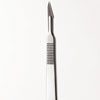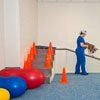Veterinary Medicine Essentials: Canine cranial cruciate ligament (CCL) injuries
Each Veterinary Medicine Essentials package covers diagnostic steps, treatment plan guidance and the latest updates, plus resources to share with your entire veterinary team and your clients.

Just as with any injury, dogs that come into your veterinary practice with cranial cruciate ligament (CCL) injuries need a treatment plan tailored specifically to their case. Is a surgical approach the best thing for that patient? And which surgical approach should you take? Innovations are made constantly in this area of medicine. But don't worry, this Essential is here to keep you in the loop of all things relevant to CCL repair.
Updates on CCL injuries

Brace yourself: Client satisfaction with orthotics vs. TPLO for cranial cruciate ligament injuries
Aug 22, 2016
Study investigates owner perception of management of dogs with nonsurgical vs. surgical methods, including outcomes, complications and after care. ...
Critical decisions in cranial cruciate ligament repair
May 10, 2016
Painful and debilitating for patients, expensive versus less effective repair options for clients, WAY too many recommended surgical approaches for you. Are you limping toward the best plan? ...
Cranial cruciate ligament repair: One size does NOT fit all
Apr 28, 2016
No, there is no cookie-cutter method to treating this injury in dogs. But here are a few pointers to make your decision process a little easier. ...
Video: Bracing for cranial cruciate ligament injury
Oct 02, 2014
Are braces an OK option for treating this common injury in canines? ...
Diagnosing CCL injuries

Bad hips and knees: Is it hip dysplasia or a torn cruciate ligament?
It can be difficult to differentiate between these two orthopedic problems. Luckily, the sit test, among other diagnostic evaluations, can help. ...
7 benefits of sedation for orthopedic examinations
Trying to determine whether a patient has hip dysplasia or a cranial cruciate ligament tear? Here's why sedation may be called for. ...
The seven most common reasons Fido might limp into your clinic (Sponsored by Purina Veterinary Diets)
An overview of the diagnosis and treatment of common injuries that cause lameness in dogs ...
Diagnosing cranial cruciate ligament pathology
Recent advances in diagnostic visualization and surgical treatments have stimulated an increased emphasis on early clinical recognition of cranial cruciate ligament pathology. This article describes characteristics of normal and pathologic cranial cruciate ligaments and details clinical techniques to help you diagnose cranial cruciate ligament pathology earlier. ...
CCL injuries: Nonsurgical therapy

Alternative therapies for managing mobility: Nonsurgical management of cranial cruciate ligament rupture (Sponsored by Iams)
Osteoarthritis (OA) affects about 20% of canine patients. However, that estimate is probably low because there are many dogs with undiagnosed OA for which owners have not sought treatment. ...
Orthopedic devices (stifle braces, orthotics, etc.) (Proceedings)
In the field of small animal orthopedics, orthoses, prostheses and other assistive devices are an emerging technology that can aid in the well-being of our canine patients. These devices are used to either correct or accommodate the affected limb(s) following trauma or surgical intervention, and may be utilized as temporary or permanent modalities. ...
Treating tendon and ligament injuries in dogs--from surgery to platelet-rich plasma to laser therapy (Proceedings)
Tendon and ligament injuries can be serious enough to not only affect performance but to end a dog's career. ...
CCL injuries: Surgical therapy

Journal Scan: Ruptured CCL surgery: TPLO vs. extracapsular repair
A study looks at which repair technique is best to get dogs back on all four paws. ...
Choosing cruciate rupture repair methods (Proceedings)
Cranial cruciate ligament rupture is a common cause of hindlimb lameness in dogs and is seen in cats as well. ...
Surgery STAT: Tightrope CCL for treating canine cranial cruciate deficiency
Treatment of cranial cruciate ligament deficiency is the most common surgical procedure performed in veterinary orthopedics. ...
Surgery STAT: TTA vs. TPLO: Recovery time remains an important consideration
In the first article in this series, we provided a brief overview of the two surgical procedures that addressed the active, abnormal biomechanics of the cranial cruciate ligament deficient stifle-Tibial Tuberosity Advancement and Tibial Plateau Leveling Osteotomy. ...
Surgery STAT: Correcting cranial cruciate ligament-deficient stifles
The Tibial Tuberosity Advancement (TTA) is a procedure developed in Zurich, Switzerland, in the early 2000s. The biomechanics behind its success for correcting cranial cruciate ligament-deficient stifles is a change in the patellar tendon angle that effectively neutralizes the tibiofemoral shear (tibial thrust) that occurs during weight bearing. ...
Understanding tibial plateau leveling osteotomies in dogs
Cranial cruciate ligament pathology is a leading cause of lameness in dogs. Many surgical treatments have been described that aim to restore stifle joint stability and minimize the progression of subsequent osteoarthritis. Most surgical treatments seek to replace the function of the cranial cruciate ligament by substituting autologous tissues or synthetic materials. More recently, the tibial plateau leveling osteotomy (TPLO) procedure has been described, which alters the mechanical forces acting on the stifle, rendering the cranial cruciate ligament unnecessary. ...
Rehabilitation after CCL injury

CVC highlight: DIY veterinary rehabilitation for patients with patella and cruciate injuries
Dr. Wardlaw discusses some therapeutic alternatives to get orthopedic patients comfortably back on their feet. ...
Getting dogs back on their paws
A Q&A with canine physical rehabilitation expert Darryl Millis, DVM. ...
Therapeutic exercise in veterinary rehabilitation
Therapeutic exercise can provide a wide range of benefits for veterinary rehabilitation patients. ...
Underwater treadmill therapy in dogs
This physical therapist and certified canine rehabilitation practitioner discusses canine physical therapy and demonstrates underwater treadmill therapy in a German shorthaired pointer with a partial cranial cruciate ligament tear and a German shepherd dog with type II intervertebral disc disease and hip dysplasia. ...
Underwater treadmill therapy in veterinary practice: Benefits and considerations
An underwater treadmill, or hydro-treadmill, can be a valuable addition to any practice. ...
Arming your team to aid in rehabilitation

Canine rehabilitation: Getting orthopedic patients back on their feet
Cranial cruciate ligament tears and ruptures are common conditions that can lead to debilitating osteoarthritis. Consider a veterinary team approach to canine rehabilitation to improve every patient's quality of life. ...
10 easy ways to promote your rehab services
Do your veterinary rehabilitation services need some marketing rehab? Get in the underwater treadmill with us and we'll help flex those flabby client-acquisition muscles. ...
Physical rehabilitation at your veterinary hospital
Physical rehabilitation is the best way to help patients heal quicker, safer, and improve their overall quality of life. ...
Rehab client education handout
Download this PDF handout with all the owners about pet physical rehabilitation. ...
How rehab helps pets
A quick Q&A to get you up to speed on rehabilitation. ...